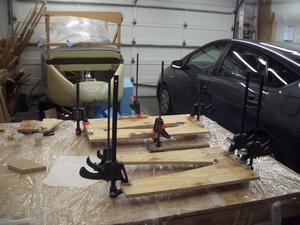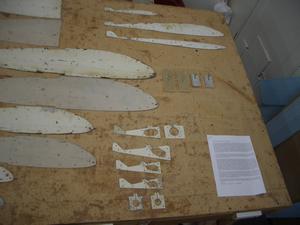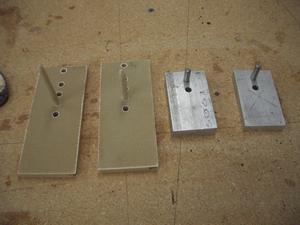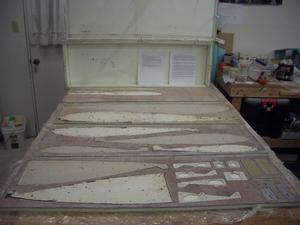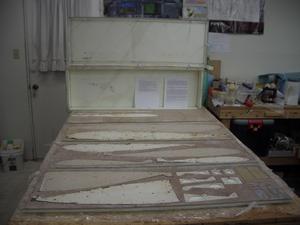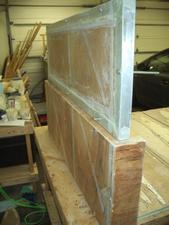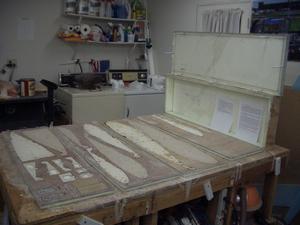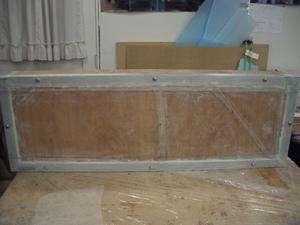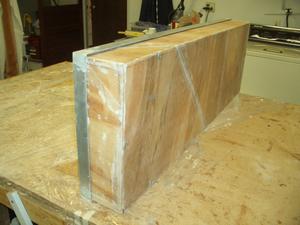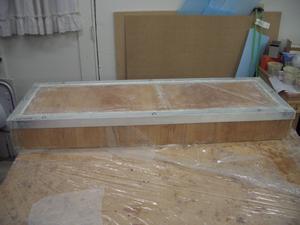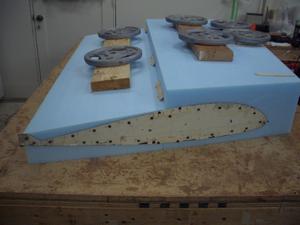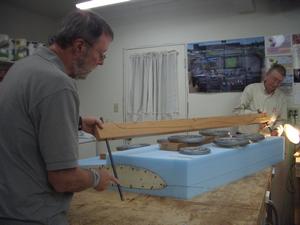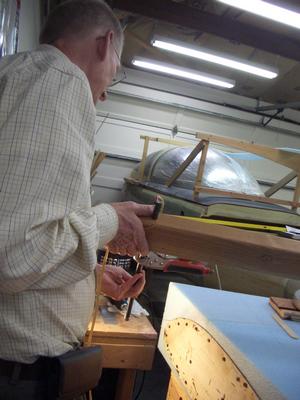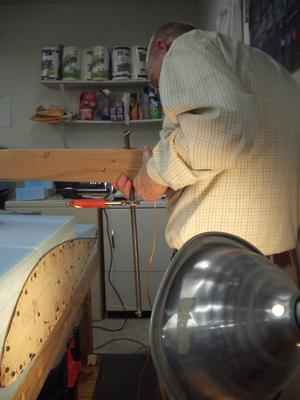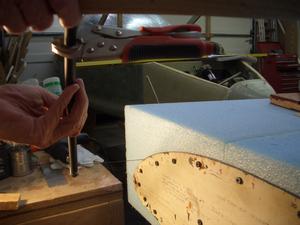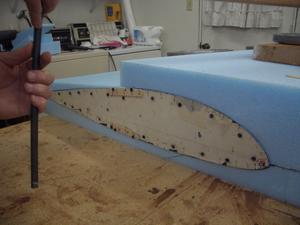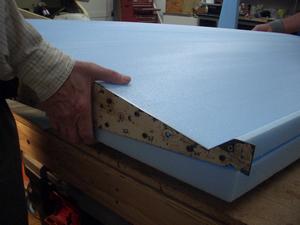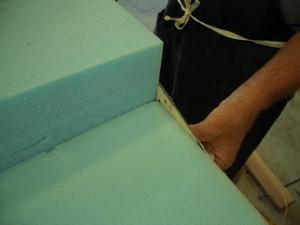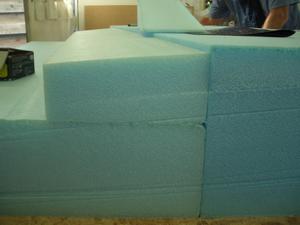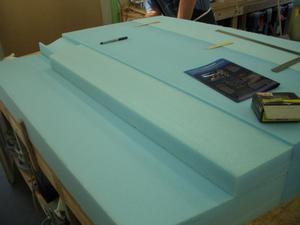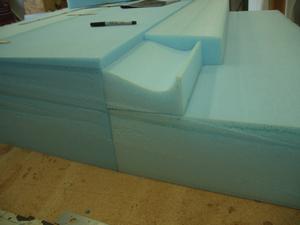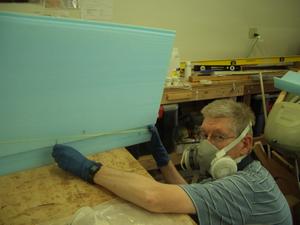Page updated on: March 8, 2016
Chapter 19 - Wings & Ailerons
Quick links within this page:
Step 1 - Building the wing jigs
Step 2 - Setting up the jigs
Tracking down the wing templates
Step 3 - Cutting foam cores
Step 4 - Assembly of foam cores & lay up of shear web
Step 5 - Bottom spar cap
Step 6 - Bottom skin
Step 7 - Top spar cap
Step 8 - Top skin
Step 9 - Wing ribs
Step 10 - Ailerons
Step 11 - Controls
Step 12 - Attachment, wing to center section spar
Chapter Overview
This is it The big One!
In this chapter, Jeff and I will build the wings! This is the chapter we have been waiting for. It is huge and will take a few months to a year to complete.
Building the wings will involve making jig templates, cutting the foam cores for the shape of the wing, laying up a shear webs, spar caps and skins. Then we'll install wing attachment reinforcements, build and rig the ailerons and install wing-mounted aileron controls.
WoW! This is going to be a fun chapter!
Step 1 - Building the wing jigs
In this step, jigs are made using plywood. These jigs will be used to align the wing foam and hold it in place as the fiberglass is applied. These are needed as the foam has a tendency to twist as stresses in the foam are relieved after hot wiring. The jigs will straighten the foam out so they will have the proper twist when fiberglassed.
The plans call for using 1/2 inch plywood, however, some builders have had problems with the plywood being too flimsy. Some of these builders recommended using 3/8 inch thick plywood, which is what I am using.
Once the jigs are cut out, they are then cut into 4 pieces. These pieces are are then held together using plywood "links". One side of the link is flox'd to one of the pieces and the other side is bolted to the adjoining piece. This allows the jigs to be separated, as needed, to be able to access the foam when applying fiberglass.
Step 2 - Setting up the jigs
Details of step will go here
Tracking Down the Wing Templates
Many years ago, John Epplin made some steel wing templates. He worked with the designer, Nat Puffer, to get the correct shape for the templates. He then input the shape into a CAD program and had the steel cut using a water jet cutting technique. These templates are easy to use and having them available saves the builders a lot of time as they do not have to make their own templates from the plans.
These templates have been passed from builder to builder for many years. I first became aware of them when Ted Davis in Hollister asked me to help him cut his wing cores in 2007. He had received the templates and was excited about hot wiring his wings. After helping him, I saw what an advantage it was to use them and I was hoping to use them in a couple of years when I started building my wings. Wellll, as you can see, quite a few years have passed since then as it is now 2015 ;-)
Unfortunately, when I queried the Cozy Builders Mailing list as to who had them, no one knew. One builder even told me they were in horrible shape and were probably no longer available. Not being discouraged, I went on a two month search, tracking them down. Fortunately, I had started a couple of months before I actually needed them.
I started by searching the archives for the Cozy Builders Mailing list. The last mention of them was in 2009 and it is now 2015 as I write this, so they have been lost for 6 years. In one of the posts, I saw that Nick Ugolini had created a database on his website to keep track of the templates. I contacted Nick and he said the website he had been using no longer exists, but he did have an archive of it. He was able to send me about 5 names and addresses of people that were on the list. I sent an EMAIL to each one, no response. I then sent a snail mail letter to the last person that had the templates. It turns out that he was no longer using the EMAIL address listed in the database, however, he did send me an EMAIL after receiving my letter. He told me whom he had sent them to and when. I then found that persons EMAIL and sent him a message. He told me whom he had sent them to. After going through a few more people, I had tracked the templates to 2012 and this person still had them! YEA!!! He put them in the mail to me right away. It turns out, he had had them for the past 2.5 years and was waiting for someone to request them, unfortunately, he was no longer monitoring the Cozy Builders Mailing list.
After about a week, the templates arrived, what an exciting day! On the lid of the box, was an inventory. Oooops, the templates for the winglets were NOT in the box :-( I sent a message to the person who had sent me the templates asking if he had used them. I didn't get a response, probably due to it being Memorial Day weekend, however, the person I had sent a snail mail letter to contacted me asking if I had found the templates. I told him, I had, but the winglet templates were missing. He said he had made his own winglet templates, in 2009, as the person who had sent him the wing templates had held onto the winglet templates until he had bought more foam to make them. I asked if he would contact that person to see if he still had them. Sure enough, he still had them. He contacted me and I gave him my address to send them to. In about a week, the winglet templates arrived, YEA!!! I now have the complete set of templates.
The templates are in very good shape, however, the pasted on paper template on each of the steel templates is in poor condition. They are still usable, however, some of the talking point numbers are missing.
I believe the paper templates are being damaged by the rubbing between the templates when they are shipped. The original box used for shipping had all the templates laying against each other, then they were compressed by outsides of the box. I felt a better case was needed for the templates, so I built one. It is made of foam, fiberglass and very thin plywood. Each template now has it's own cutout location so it cannot slide around. I'm hoping the new box will preserve the templates.
This has been a fun adventure in tracking them down and building a new shipping container for them. I'm happy that I'll be able to pass a complete set of templates on to other builders to use. What an adventure! These types of adventures are always fun, when you have a successful outcome. Okay, time to get back to building the plane ;-)
Step 3 - Cutting foam cores
The wings are made of foam covered with fiberglass. Using foam is an easy way to get the required shape of the wings.
The foam is cut using a hotwire which is guided along a template. The hot wire melts it's way through the foam producing an accurate wing shape.
Step 4 - Assembly of foam cores & lay up of shear web
Details of step will go here
Step 5 - Bottom spar cap
Details of step will go here
Step 6 - Bottom skin
Details of step will go here
Step 7 - Top spar cap
Details of step will go here
Step 8 - Top skin
Details of step will go here
Step 9 - Wing ribs
Details of step will go here
Step 10 - Ailerons
Details of step will go here
Step 11 - Controls
Details of step will go here
Step 12 - Attachment, wing to center section spar
Details of step will go here

